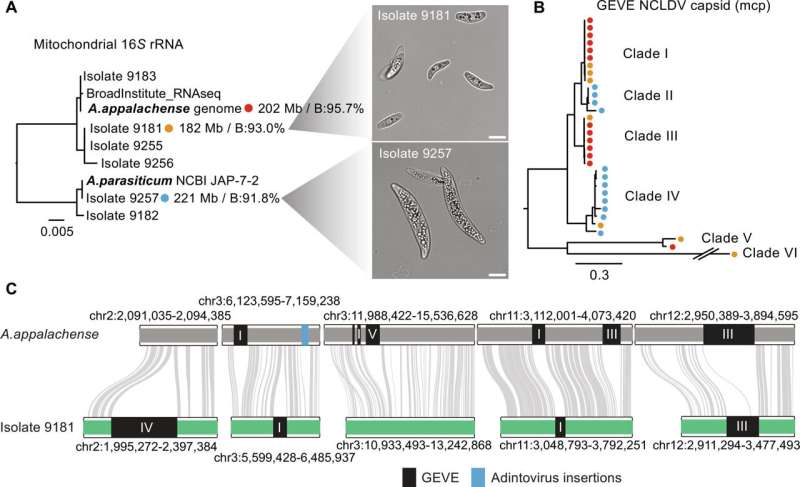This article has been reviewed according to Science X's editorial process and policies. Editors have highlighted the following attributes while ensuring the content's credibility:
fact-checked
peer-reviewed publication
trusted source
proofread
Ancient microbes offer clues to how complex life evolved

A new study published in Science Advances reveals a surprising twist in the evolutionary history of complex life. Researchers at Queen Mary University of London have discovered that a single-celled organism, a close relative of animals, harbors the remnants of ancient giant viruses woven into its own genetic code. This finding sheds light on how complex organisms may have acquired some of their genes and highlights the dynamic interplay between viruses and their hosts.
The study focused on a microbe called Amoebidium, a unicellular parasite found in freshwater environments. By analyzing Amoebidium's genome, the researchers led by Dr. Alex de Mendoza Soler, Senior Lecturer at Queen Mary's School of Biological and Behavioural Sciences, found a surprising abundance of genetic material originating from giant viruses—some of the largest viruses known to science. These viral sequences were heavily methylated, a chemical tag that often silences genes.
"It's like finding Trojan horses hiding inside the Amoebidium's DNA," explains Dr. de Mendoza Soler. "These viral insertions are potentially harmful, but Amoebidium seems to be keeping them in check by chemically silencing them."
The researchers then investigated how widespread this phenomenon might be. They compared the genomes of several Amoebidium isolates and found significant variation in the viral content. This suggests that the process of viral integration and silencing is ongoing and dynamic.
"These findings challenge our understanding of the relationship between viruses and their hosts," says Dr. de Mendoza Soler. "Traditionally, viruses are seen as invaders, but this study suggests a more complex story. Viral insertions may have played a role in the evolution of complex organisms by providing them with new genes. And this is allowed by the chemical taming of these intruders DNA."
Furthermore, the findings in Amoebidium offer intriguing parallels to how our own genomes interact with viruses. Similar to Amoebidium, humans and other mammals have remnants of ancient viruses, called endogenous retroviruses, integrated into their DNA.
While these remnants were previously thought to be inactive "junk DNA," some might now be beneficial. However, unlike the giant viruses found in Amoebidium, Endogenous retroviruses are much smaller, and the human genome is significantly larger. Future research can explore these similarities and differences to understand the complex interplay between viruses and complex life forms.
More information: Luke A. Sarre et al, DNA methylation enables recurrent endogenization of giant viruses in an animal relative, Science Advances (2024). DOI: 10.1126/sciadv.ado6406
Journal information: Science Advances
Provided by Queen Mary, University of London





















